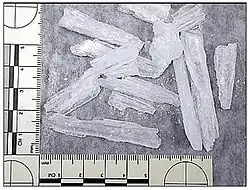Isopropylbenzylamine
N-isopropylbenzylamine is a compound that has appeared in chemical literature often playing an intermediary role in applications of experimental synthesis and novel organic transformations. Despite having limited documented uses, it is most well known for having previously come to the attention of the DEA due to being used by illicit methamphetamine manufacturers as a diluent of or substitute for methamphetamine, with many recorded sightings occurring in the years 2007-2008.[2][3][4][5] As of 2018, researchers from the DEA associated with the Methamphetamine Profiling Program, which categorizes route-specific and other impurities in seized drug samples, has stated that isopropylbenzylamine appears only "occasionally".[6] This compound is a chain isomer of methamphetamine that exhibits the same chemical formula and molar mass giving their hydrochloride salts similar physical properties, such as relatively close melting points and comparable appearance. Consequently, it can be used as a substitute or diluent of methamphetamine without this being obvious to users, though the differing melting points and various attributes of its presentation such as softer or more easily broken crystals have been noted as a possible indication of its presence.[5] In Australia it is known to be a border controlled substance.[7] It currently is unknown to be a controlled substance in any other jurisdiction. Isopropylbenzylamine is not thought to have any stimulant effects in its own right, though anecdotal reports suggest that it may be associated with side effects such as headaches and confusion which are not typically associated with methamphetamine itself. The toxicity of N-isopropylbenzylamine has been studied as of 2022 and it has been found to produces toxicity via increasing nitric oxide in vitro. In this study, in vitro toxicity of N-isopropylbenzylamine and its toxicity-related targets were investigated in SN4741, SH-SY5Y or PC12 cell lines that model neurons. The study sounds an alarm for methamphetamine abusers and warns of the dangerousness of N-isopropylbenzylamine for public health.[8][4] Other "cutting agents" found to have been used for methamphetamine include the related compounds methylbenzylamine and ethylbenzylamine, as well as dimethylsulfone.[3][9]

 | |
 | |
| Names | |
|---|---|
| Preferred IUPAC name
N-Benzylpropan-2-amine | |
| Other names
N-(Phenylmethyl)propan-2-amine Isopropylbenzylamine | |
| Identifiers | |
3D model (JSmol) |
|
| ChemSpider | |
| ECHA InfoCard | 100.002.789 |
PubChem CID |
|
| UNII | |
CompTox Dashboard (EPA) |
|
| |
| |
| Properties | |
| C10H15N | |
| Molar mass | 149.237 g·mol−1 |
| Pharmacology | |
| Legal status | |
Except where otherwise noted, data are given for materials in their standard state (at 25 °C [77 °F], 100 kPa).
Infobox references | |
Legality
In the United States, Isopropylbenzylamine may be considered a Schedule II substance as a positional isomer of Methamphetamine (C10H15N), due to the Schedule II definition of Methamphetamine defined as "any quantity of methamphetamine, including its salts, isomers, and salts of isomers"[10][11][12]
References
- Anvisa (2023-07-24). "RDC Nº 804 - Listas de Substâncias Entorpecentes, Psicotrópicas, Precursoras e Outras sob Controle Especial" [Collegiate Board Resolution No. 804 - Lists of Narcotic, Psychotropic, Precursor, and Other Substances under Special Control] (in Brazilian Portuguese). Diário Oficial da União (published 2023-07-25). Archived from the original on 2023-08-27. Retrieved 2023-08-27.
- "Northwest Association of Forensic Scientists Fall 2008 Newsletter" (PDF). 2008. Retrieved 12 October 2019.
- "N-BENZYLMETHYLAMINE HCL AND N-BENZYLETHYLAMINE HCL ('ICE' AND CRYSTAL METHAMPHETAMINE MIMICS) IN THE SOUTHWEST" (PDF). Microgram Bulletin. August 2007.
- "Very large seizure of N-isopropylbenzylamine hydrochloride in Bakersfield, California" (PDF). Microgram Bulletin. 41 (4): 38–39. April 2008.
- Sanderson, Ramona M (2008). "Identification of N-Methylbenzylamine Hydrochloride, N-Ethylbenzylamine Hydrochloride, and N-Isopropylbenzylamine Hydrochloride" (PDF). Microgram Journal. 6 (1–2): 36–45.
- Li, Li; Brown, Jaclyn L.; Toske, Steven G. (July 2018). "Simultaneous detection and quantitation of organic impurities in methamphetamine by ultra-high-performance liquid chromatography-tandem mass spectrometry, a complementary technique for methamphetamine profiling". Drug Testing and Analysis. 10 (7): 1209–1219. doi:10.1002/dta.2388. PMID 29633543.
- "Three Indian nationals arrested in Melbourne over multiple alleged drug importation attempts". Australian Criminal Intelligence Commission. Retrieved 2021-10-07.
- Xu, Peng; Li, Haijie; Qiu, Qiyang; Xiao, Xiao; Qiu, Yi; Li, Xiangyu; Wang, Youmei; Zhou, Wenhua; Shen, Haowei; Cui, Wei (1 October 2022). "N-isopropylbenzylamine, a methamphetamine mimics, produces toxicity via increasing nitric oxide in vitro". Toxicology. 480: 153337. doi:10.1016/j.tox.2022.153337. PMID 36162621. S2CID 252500676.
- Weston, Robert G. (15 March 2010). "Quick Screening of Crystal Methamphetamine/Methyl Sulfone Exhibits by Raman Spectroscopy: QUICK SCREENING OF CRYSTAL METH BY RAMAN". Journal of Forensic Sciences. 55 (4): 1068–1075. doi:10.1111/j.1556-4029.2010.01336.x. PMID 20345801. S2CID 39065054.
- http://isomerdesign.com/Cdsa/FR/36FR12734.pdf
- "21 U.S. Code § 812 - Schedules of controlled substances".
- https://www.govinfo.gov/content/pkg/STATUTE-84/pdf/STATUTE-84-Pg1236.pdf